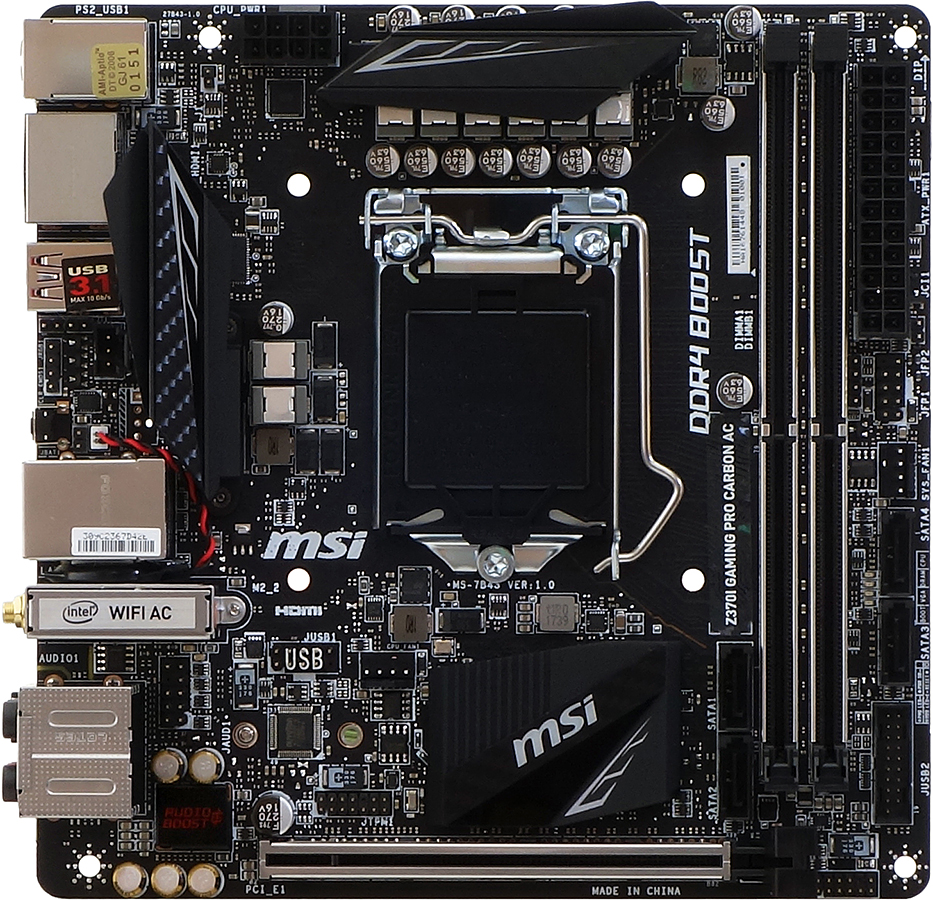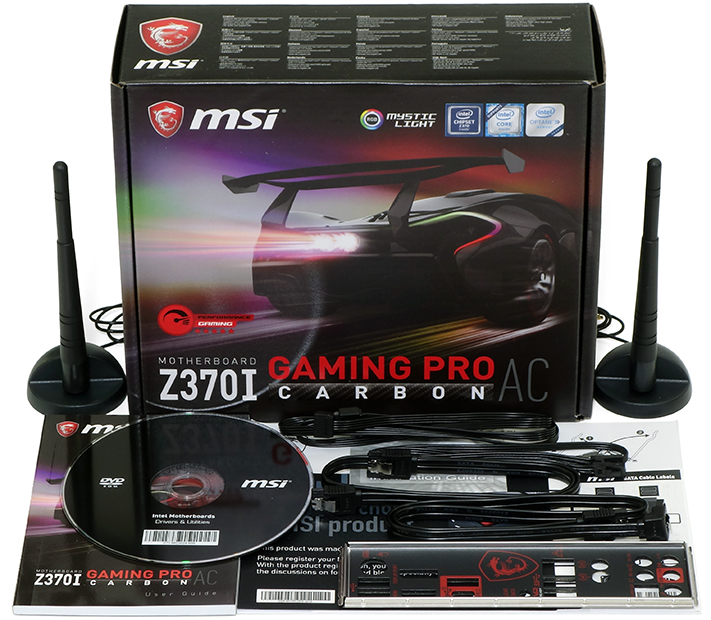Early Verdict
Buyers who want a super-fast, super-stable, super-efficient Mini ITX board will probably love the Z370I Gaming Pro Carbon AC. Buyers who think they’re paying for features will probably buy something with more features.
Pros
- +
Excellent performance
- +
ATX-class CPU overclocking
- +
Ultimate DRAM overclocking
- +
High efficiency
- +
Less crowding due to fewer connectors
Cons
- -
Single M.2 interface lacks SATA M.2 support
- -
Single case fan header
- -
Sacrifices connectors to reduce crowding
Why you can trust Tom's Hardware
Features & Layout
It’s important for a few of us to remember that many buyers want a system that only does a few things extremely well, particularly when we’re looking at the variety of interfaces some boards make available to end users. A gaming system builder once asked me to recommend an extreme overclocking board with only four USB ports and one front-panel USB header. MSI’s Z370I Gaming Pro Carbon AC isn’t quite that sparse.
Rather than pack the top surface with a bunch of controllers and M.2 slots, MSI decided to focus on expanding the voltage regulator of its Z370I Gaming Pro Carbon AC. We find one USB 3.0 header (which MSI likes to call USB 3.1 Gen1), one USB 2.0 header, four SATA ports, and a few miscellaneous connectors near the I/O panel. As for what’s under the board, well, that begins with RGB LEDs.
Specifications
Under-board features nearly end at that point, as the only other two things of interest are the M.2 connector and the Gigabit Ethernet PHY. Various power regulation components are also scattered about, but we were a little surprised to see that the board only supports a single PCIe 3.0 x4 M.2 drive. Legacy SATA M.2 drives are excluded, according to MSI.
The I/O Panel isn’t complicated either, with its single Type-C and single Type-A USB 3.1 Gen 2 ports, two USB 3.0 ports, and two USB 2.0 ports. The Z370’s 30-device HSIO resource limitation is the best reason for manufacturers to add USB 2.0 ports to the I/O panel of fully loaded ATX boards, but the Z370I Gaming Pro Carbon AC is as far from that standard as the performance enthusiast market would allow it to go.
We also find a PS/2 port, which can be handy for legacy keyboards or mice, the RJ45 connector for the previously mentioned Ethernet controller, two Wi-Fi antennas on an M.2 Key-E riser, five analog audio jacks, a digital optical jack, a DisplayPort adapter that only supports 24Hz output at its 4096x2304 maximum resolution, an HDMI output that only supports 30Hz output at its 4096x2160 maximum resolution, and a CLR_CMOS button. That configuration appears perfectly targeted at the home gaming market where the scarcity of DTS-Connect receivers pushes gamers to choose analog outputs for their live 3D audio streams. The Nahimic virtual surround likewise strengthens MSI’s marketing appeal within the headphone-wearing portable gaming market.
Perhaps MSI was trying to provide more air space around its voltage regulators when it decided to use a big chunk of I/O Panel real estate for internal headers? In that gap we find a four-pin RGB header, a proprietary three-pin version that allows MSI’s Mystic Light software to control Corsair’s addressable LED strips and fans, an undefined header labeled JT1, and a secondary set of pins adjacent to the clock battery connection. The Z370I Gaming Pro Carbon AC follows the recent Mini-ITX trend of placing its front panel audio header above the graphics card slot, behind the Z370 PCH, front-panel USB 2.0, and CPU fan headers.
The front edge USB 3.0 connector is perpendicular to the board’s surface to avoid fitment issues in cases that have drive racks or power supplies mounted in front of the board. Above it are two of the four SATA ports, the single case fan header, and the front panel LED/switch group. Two more SATA ports are placed between the DIMMs and Z370 PCH, forcing users to pull a couple cables if they’d like to replace their DRAM. MSI was smart enough to face the latching side of those two SATA ports away from DIMMs, but most users will need to pull their memory to access latches on the forward SATA ports.
Get Tom's Hardware's best news and in-depth reviews, straight to your inbox.
MSI miniaturized the Z370I Gaming Pro Carbon AC’s manual so it would fit inside the box a certain way, rather than leave it full size and turn it the other way. The installation kit includes two Wi-Fi antennae, a standard RGB extension cable, a three-pin Corsair HD RGB cable, two SATA cables (one with a single right-angle end), an I/O shield, cable label stickers, and a driver/application disc.
MORE: Best Motherboards
MORE: How To Choose A Motherboard
MORE: All Motherboard Content
-
Lutfij The point with limited fan headers might also be due to the fact that you can source a PWM splitter that is molex/sata powered and you can use the breakaway's to manage more than one(upto eight) fan(s) in a case.Reply
The review is simple and spot on, bravo, Thomas! ;) -
Crashman Reply20564490 said:The point with limited fan headers might also be due to the fact that you can source a PWM splitter that is molex/sata powered and you can use the breakaway's to manage more than one(upto eight) fan(s) in a case.
The review is simple and spot on, bravo, Thomas! ;)
I realize these are small boards for small cases and don't have much room for extras, but I only required three fan headers. One for the front of the case, one for the back and one for the CPU cooler. I don't think that's too much to ask :) -
mortemas Where's the ASRock Fatal1ty Z370 Gaming-ITX/ac? I don't see much talk of it anywhere, let alone this review where it would have been a good apples to apples comparison.Reply -
Crashman Reply
Good question! I don't have one, and they haven't offered it yet.20572043 said:Where's the ASRock Fatal1ty Z370 Gaming-ITX/ac? I don't see much talk of it anywhere, let alone this review where it would have been a good apples to apples comparison.





